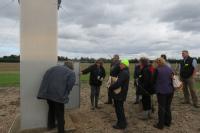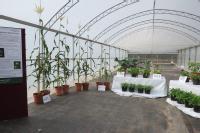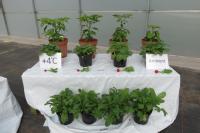Coping with Climate Change
The growth of plants, and the life-cycles of the pests and diseases that damage them, are heavily influenced by the weather. As a consequence of global warming, seasonal and regional alterations in temperature and the pattern of rainfall are predicted which will have an impact on productivity and the use of land and other resources.
Target predictions for the UK have been produced by the UK Climate Impacts Programme and are being used at Warwick to evaluate the potential impacts of climate change on crop growth and development and their associated pest and diseases.
A suction trap network, run by the Rothamsted Insect Survey is used primarily to monitor aphids. Daily samples are taken from the suction trap during the 'aphid season', with data accumulated over many years being used to identify relationships between aphid abundance, timing of activity and weather conditions. These relationships can then be used in conjunction with climate change scenarios to predict the impace of climate change on pest aphids.
Rosemary Collier explained the operation of the suction trap and the predicted impacts of climate change on pest aphids.
In the United Kingdom current climate models suggest average temperatures could be 4°C warmer by 2080. The impact of this temperature rise on the behaviour of weeds is poorly understood.
To address this Steve Footitt and Bill Finch-Savage, who were available to discuss their work, are studying the impact of global warming using Warwick Crop Centres unique Thermal Gradient Tunnels. Using a system of temperature sensors, heaters and fans these 30 meter tunnels can maintain a temperature gradient equal to the external ambient temperature at the cold end of the tunnel to +4°C at the warm end. This gives an annual season cycle in which climate scenarios from the present day to 2080 can be tested.
Using winter and summer annual ecotypes of Arabidopsis thaliana (Thale cress) a member of the Brassicaceae family they are investigating the impact of global warming on flowering time and seed germination the two major transitions of the plants life cycle:
Flowering time determines the time of year (environment) under which seeds develop and mature. This in turn determines dormancy levels in the seed population via temperature sensing.
Dormancy cycling driven by seasonal temperature cycles determines the time of year that seed are most likely to germination and emerge as seedlings in their natural environment.
To investigate the potential genetic link between flowering and dormancy the Finch-Savage group have developed a Recombinant Inbred Line population produced from a cross between the early flowering and highly dormant Arabidopsis winter annual ecotype Cape Verdi Isle and the late flowering and shallow dormant summer annual ecotype Burren. This population is currently being analysed under a range of global warming scenarios.
BBC Midlands Today Springwatch interview



